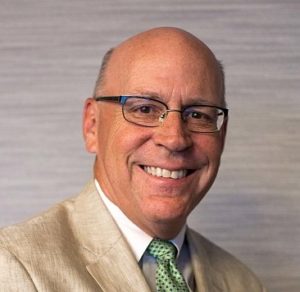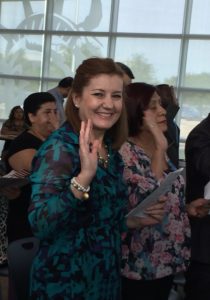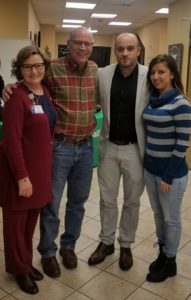 Santa Lopez’s journey to United States citizenship started long before she walked into my citizenship class at The Crossing Baptist Church in Mesquite, Texas.
Santa Lopez’s journey to United States citizenship started long before she walked into my citizenship class at The Crossing Baptist Church in Mesquite, Texas.
Originally from Venezuela, Santa walked out of her country in 2000. She was one of the fortunate ones. A sister living in the U.S. obtained a visa for her to get Santa to New York City. In January 2000, Santa boarded a bus in New York with a suitcase and $100. When she got off the bus in Mesquite, the suitcase was missing and most of the $100 was gone.
Friends in the Dallas area helped her find work – work most Americans would never do – cleaning bathrooms, being a nanny, cooking in restaurant kitchens, cleaning homes. Anything was better than living the under boot of her country’s dictator, Hugo Chavez.
So, as I have seen images of the so-called migrant caravan, I couldn’t help but think of Santa. She changed my life and gave me a new passion.
‘We want to be good citizens’

Mercedes Martin, a graduate of the citizenship class, at her citizenship swearing-in ceremony. She is originally from Mexico. (Photos by Scott Collins)
Santa was in the first citizenship class I ever taught in 2013. I had taught English as a Second Language (ESL) for years when I saw the need for helping my students take the next step. The Crossing is a small, multi-cultural congregation in the Dallas area. Our ESL classes are comprised of people from all over the world, including every Latin American country, Iraq, Israel and Myanmar.
During the third class session, I was helping students memorize the answers to the 100 questions on the civics test all applicants have to take. Santa stopped me and with one sentence gave me a passion for this.
“Scott,” she said, “we don’t want to just memorize the answers. We want to learn them so we can be good citizens.”
I’ve been hooked ever since. And if you think that got me, you should go to a swearing-in ceremony when one of my graduates becomes a citizen of the United States of America.
Every Wednesday night, we gather in a small classroom at the church. Since the change of administrations in Washington, business has been brisk. Students who have lived in the United States for more than 20 years live in fear of losing their permanent legal status, or “Green Card.” And since the Trump administration started removing the Temporary Protected Status (TPS), I’ve had students working to get their citizenship in hopes of helping family members being forced to return to dangerous situations back home in countries like El Salvador.
Nothing to fear
For most students the biggest hurdle, other than language, is fear. Keep in mind that by the time they get to my class, they have legal permanent status, qualifying them for citizenship. Still, they live in fear of the unknown.
“For most students the biggest hurdle, other than language, is fear.”
Other than preparing them for the process, the most important thing I give the students is confidence.
We concentrate on four steps – the civics test, the 20-page application, practicing the interview and writing some basic English sentences. The process reminds me of the old saying that Ginger Rogers did everything Fred Astaire did, except she did it backwards and in heels. That’s what it’s like for citizenship students. All of this is being done in a second language, and every step feels like you could fall off the edge.
It’s also messy. Like when you start reviewing the application and ask a student if he’s ever been deported and he lowers his head. Fear. And yet he has his green card and legal status, so he’s OK. Or is he?
The first Wednesday after Donald Trump was inaugurated, my class size tripled. Documented residents who have lived here for 25 years showed up out of a fear sparked by all the explicit and implicit messages of not being wanted amid the barrage of bombastic, election-year language. And it happened again during the recent mid-term elections.
I love watching reactions to the occasional social media post I make about teaching these classes. I have friends on the far right who think it’s the greatest thing in the world to help people become U.S. citizens. And my friends on the left see it as a progressive response to anti-immigration chatter. Maybe I’ve found something we can all agree on.

Nader Zaxoyi and his wife, Fairoz, with Scott and Judy Collins at the ESL/citizenship Thanksgiving banquet. Nader is one of several Iraqi refugees who achieved U.S. citizenship after attending the English as Second Language and citizenship classes.
It’s a ministry
I invited Santa to speak at our annual ESL/citizenship Thanksgiving banquet to prod and encourage the current students. I was the one prodded.
Since earning her citizenship in 2013, she has been able to bring all four of her daughters and their families to the U.S. from Venezuela. The daughters have professional careers as a lawyer, college professor and communications executive, and one daughter and son-in-law are about to enter seminary. Since coming here, all four daughters have come to faith in Christ. She also brought her first-ever U.S.-born grandchild to the banquet.
It started with Santa walking into our church to attend ESL and then transitioning to the citizenship classes. It didn’t start out as evangelism.
But Santa’s story is a reminder that God uses what we plant. It’s a reminder that the distinctions we put up between social ministries and evangelism are a false human dichotomy that doesn’t exist.
It amazes me to hear people talk about immigration reform when they have never met an immigrant. Immigration is not about policies and procedures. It’s about people – people with families and faces.
Until we stop seeing this as a problem and start seeing immigrant people, whether documented or undocumented, as persons created in the image of God, we will never do what is right. Put a human face on a “problem” and you immediately start finding solutions. I have plenty of faces to remind me.
